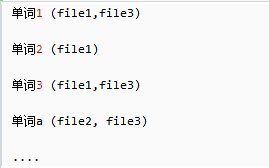1、什么是倒排索引。
e>>>(⊙o⊙)… 这是我见过最垃圾的翻译了,完全让人误解他的意思。
这个名称很容易让人理解为从A-Z的排序颠倒成Z-A,其实根本不是这么回事。
英文 原版为 inverted index 个人感觉翻译成 反向索引 比较合适。
倒排索引是区别于正排索引(forward index)来说的。
解释:
文档是有许多的单词组成的,其中每个单词也可以在同一个文档中重复出现很多次,当然,同一个单词也可以出现在不同的文档中。
正排索引(forward index):从文档角度看其中的单词,表示每个文档(用文档ID标识)都含有哪些单词,以及每个单词出现了多少次(词频)及其出现位置(相对于文档首部的偏移量)。
倒排索引(inverted index,或inverted files):从单词角度看文档,标识每个单词分别在那些文档中出现(文档ID),以及在各自的文档中每个单词分别出现了多少次(词频)及其出现位置(相对于该文档首部的偏移量)。
简单记为:
正排索引:文档 ---> 单词 常规的索引是文档到关键词的映射
倒排索引:单词 ---> 文档 倒排索引是关键词到文档的映射
应用场景:
倒排索引有着广泛的应用场景,比如搜索引擎、大规模数据库索引、文档检索、多媒体检索/信息检索领域等等。总之,倒排索引在检索领域是很重要的一种索引机制。
2、inverted index 的java实现
假设有3篇文章,file1, file2, file3,文件内容如下:

那么建立的倒排索引就是这个样子:

下面是对于倒排索引的一个简单的实现。该程序对于输入的一段文字,查找出该词所出现的行号以及出现的次数。
import java.io.*;
import java.util.HashMap;
import java.util.Map;
public class InvertedIndex {
private Map<String, Map<Integer, Integer>> index;
private Map<Integer, Integer> subIndex;
public void createIndex(String filePath) {
index = new HashMap<String, Map<Integer, Integer>>();
try {
File file = new File(filePath);
InputStream is = new FileInputStream(file);
BufferedReader read = new BufferedReader(new InputStreamReader(is));
String temp = null;
int line = 1;
while ((temp = read.readLine()) != null) {
String[] words = temp.split(" ");
for (String word : words) {
if (!index.containsKey(word)) {
subIndex = new HashMap<Integer, Integer>();
subIndex.put(line, 1);
index.put(word, subIndex);
} else {
subIndex = index.get(word);
if (subIndex.containsKey(line)) {
int count = subIndex.get(line);
subIndex.put(line, count+1);
} else {
subIndex.put(line, 1);
}
}
}
line++;
}
read.close();
is.close();
} catch (IOException e) {
System.out.println("error in read file");
}
}
public void find(String str) {
String[] words = str.split(" ");
for (String word : words) {
StringBuilder sb = new StringBuilder();
if (index.containsKey(word)) {
sb.append("word: " + word + " in ");
Map<Integer, Integer> temp = index.get(word);
for (Map.Entry<Integer, Integer> e : temp.entrySet()) {
sb.append("line " + e.getKey() + " [" + e.getValue() + "] , ");
}
} else {
sb.append("word: " + word + " not found");
}
System.out.println(sb);
}
}
public static void main(String[] args) {
InvertedIndex index = new InvertedIndex();
index.createIndex("news.txt");
index.find("I love Shanghai today");
}
} 其中,输入文件news.txt内容为:
I am eriol
I live in Shanghai and I love Shanghai
I also love travelling
life in Shanghai
is beautiful 输出结果为:
word: I in line 1 [1] , line 2 [2] , line 3 [1] ,
word: love in line 2 [1] , line 3 [1] ,
word: Shanghai in line 2 [2] , line 4 [1] ,
word: today not found
参考来自! 倒排索引简单实现
另外的资源学习(本文并未涉及)
MapReduce实现倒排索引(类似协同过滤)
hadoop倒排索引
来源:oschina
链接:https://my.oschina.net/u/2885163/blog/1554246